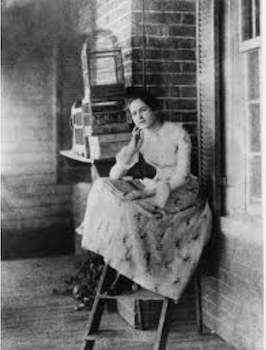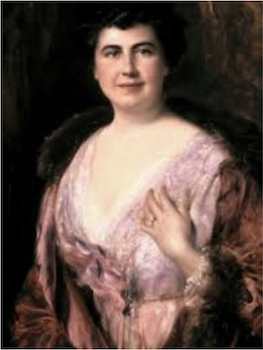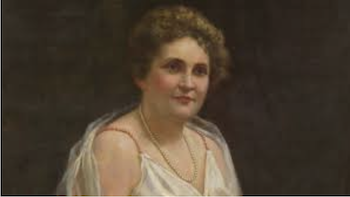
Edith Bolling Galt Wilson, born Edith Bolling, was born on October 15, 1872, in the rural town of Wytheville, Virginia. She was the seventh out of eleven children delivered to Sallie White and successful Judge William Holcombe Bolling. Wilson was born into a family of old southern aristocracy, dating the family’s ancestry all the way back to Pocahontas. Their aristocratic lifestyle was prevalent, as displayed by her father’s political standing as a judge and the ability of her parents to care for 11 children. Wilson never left Wytheville until the age of 12, causing her to receive an extremely limited education at home until the age of 15. At this time, she enrolled in the Martha Washington College for music studies for a year, and took secondary courses in Richmond, Virginia.
After completing her studies, Wilson traveled to Washington, D.C. to visit one of her sisters. During this visit, she met Norman Galt, a prominent businessman in the jewelry industry who owned a shop a couple of feet away from the White House. Galt and Wilson were married in 1896 and lived happily together for 12 childless years; they did successfully have a baby in 1903 but the child died in infancy. In 1908, Galt died, leaving Wilson heartbroken and widowed. However, Wilson knew how to take charge and didn’t sit back into her loss. Instead, Wilson became head of Galt’s jewelry business and quickly became a respected figure among the capital’s social elite. Her skyrocketing status connected her with individuals of high social standing, including President Woodrow Wilson’s cousin Helen Woodrow Bones. As a result, Bones and Wilson formed a friendship that led Wilson to meet Woodrow, who would later become her second husband.

When Woodrow and Edith met, Woodrow’s previous wife had died less than a year ago. Despite the losses of both individuals, the two fell in love and were married on December 18, 1915, nine months after being introduced. Before the marriage, Woodrow’s political advisors held concerns about how remarrying so soon after the First Lady’s death could hurt the President’s public image. Advisors even attempted to thwart the wedding, but all attempts were unsuccessful. Accordingly, they married in Wilson’s Washington, D.C. townhouse. Wilson was now the second wife to the 28th president of the United States, and her influence had taken root. Soon after their marriage, it quickly became rumored that Edith had a tremendous, sometimes negatively viewed, impact on Woodrow’s political views, causing many among the public to question her true intentions and Woodrow’s capability of holding office. It got to the point where the public rumored Woodrow’s support for women’s suffrage was a way to show the public that he had his own political values apart from his wife, with Wilson being heavily against female suffrage. However, during her time as First Lady, Edith remained a feminine fashion icon for the general public and loved to work behind the scenes with the President, learning about the inner workings of the White House.
As the U.S. entered WWI in the late 1910’s, Wilson helped in every way she could significantly. She became a primary example of the best ways to support the war effort, living her life the same way as her citizens: she wore thrifted clothes and she observed rationing. She knitted helmets and pajamas for soldiers overseas and in the trenches. She responded to all the soldier’s letters that she received and volunteered with the Red Cross at Union Station. In addition, Edith decoded secret transmissions. Her most iconic effort was to replace all hired gardeners from the White House acreage with the use of live sheep for grazing instead. She then shaved these sheep and auctioned the wool off for $50,000 to donate to charitable American causes supporting the war effort, equating to nearly one million dollars today. Wilson also tried her best to keep her husband healthy under the tremendous strain of the war, handling the aspects of presidential responsibilities that she could to ease his stress. She accompanied Woodrow to Europe for the League of Nations peace conference in France and even managed to score herself a seat inside the meeting room. While overseas, she provided extra aid to U.S. soldiers stationed and hospitalized there. She had a love for the American people, and that love would help the nation when they needed it most.

In September of 1919, Woodrow suffered from an extreme stroke that left him seriously ill and at risk of harm, a precarious position to run a nation in. Wilson knew what she had to do, and she stepped up to fulfill the roles the President couldn’t. Besides the doctors, Wilson became the only person who could communicate with Woodrow and pre-screened all matters to decide what was important enough to burden Woodrow with. Wilson hid the degree of Woodrow’s illness from the American public to prevent fear and ran the government herself to keep the country from peril. Additionally, Wilson took responsibility for the minor, yet indispensable roles of presidency so that Woodrow could focus on larger issues, as well as his recovery. Wilson decided which matters she would resolve and which must have presidential input, causing her to take on a large burden of presidential responsibility. She kept the country running in times of desperation, earning the nickname “first woman President of the United States of America.”
In 1921, at the end of Woodrow’s second term, they both retired in the Capitol. Three years later, on December 28, 1961, Woodrow died, leaving Wilson widowed once again. Determined as ever, Wilson spent the next 37 years preserving Woodrow’s presidential legacy and accomplishments for American history books. She even published an autobiography, My Memoir, in 1939 documenting her experiences in preserving Woodrow’s presidential legacy. Her legacy as the first woman to take up the mantle as President of the United States, before all American women could even vote, will forever live on. Wilson was the first woman to prove that the First Lady could be just as influential as the president, changing the course of women in the White House for the rest of history.
Why Did I Choose to Research Edith Bolling Galt Wilson?
I chose to research Edith Wilson because she paved the way for women in national politics. She is known currently as the “first female President of the United States,” showing her impact on leading the nation in times of need. I am greatly inspired by her ability to lead a country through the worst war they had seen thus far, both as a symbol and as a political leader. Her perseverance and leadership in times of crisis inspired me to research her.
Works Cited
“About Edith Wilson.” President Wilson House, http://woodrowwilsonhouse.org/wilson-topics/edith-wilson/ Accessed 2024.
Black, Allida. “Edith Bolling Galt Wilson.” The White House, http://www.whitehouse.gov/about-the-white-house/first-families/edith-bolling-galt-wilson/
Caroli, Betty Boyd. “Edith Wilson.” Britannica, 14 June 2024, http://www.britannica.com/biography/Edith-Wilson
Center, Miller. “Edith Wilson.” UVA, http://millercenter.org/president/wilson/essays/wilson-edith-1913-firstlady Accessed 2024.
“Edith Bolling Galt Wilson.” American Experience, http://www.pbs.org/wgbh/americanexperience/features/wilson-edith-wilson/
This article was published on 7/23/24